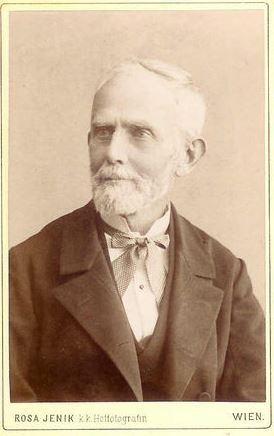|
Karol Ľudovít Libai
Karl Ludwig Libay (Slovakian: Karol Ľudovít Libai; 13 May 1814/16, Banská Bystrica – 16 January 1888, Vienna)Glocko, F.: ''Samuel Libay - život a dielo banskobystrického zlatníka.'' Banská Bystrica : Stredoslovenské múzeum, 2018, pgs.44-46 . was a Slovak lithographer, draftsman and painter. Biography His father, , was a silversmith and goldsmith. He began with the intention of becoming a goldsmith as well; serving an apprenticeship with his father from 1892 to 1832. That year, the Goldsmith's Guild promoted him to Journeyman. Two years later, aged only twenty, he achieved the status of Master. Shortly after, he went to Vienna to sharpen his skills, but his exposure to the cosmopolitanism there diverted his attention to a different kind of artistic endeavor. In 1835, he enrolled at the Academy of Fine Arts Vienna, Academy of Fine Arts. His teachers there included the portraitist, , Johann Nepomuk Ender, Leopold Kupelwieser (a friend of Franz Schubert), and the landscape ... [...More Info...] [...Related Items...] OR: [Wikipedia] [Google] [Baidu] |
Sklené Teplice
Sklené Teplice (, ) is a small spa village and municipality in Žiar nad Hronom District in the Banská Bystrica Region of central Slovakia. It is close to the historic town of Banská Štiavnica. History In historical records the village was mentioned for the first time in 1340 and was founded by Glaser Filius Gerhardi de Doplicze. Historical records for the spa come from 1549 in the chronicles of Juraj Wernher. The first spa was built in this valley in 1701. Aristocratic travelers from across Europe visited the site. The spa community achieved prominence on August 27, 1786 when the world's first academic scientific congress was held here. The congress was attended by notable intellectuals, including Johann Wolfgang von Goethe. The current spa complex dates from the early 1900s. Geography The village lies at an altitude of 360 metres and covers an area of 10.913 km². It has a population of 449 people (as of 2006). The village lies in the Štiavnica Mountains, about h ... [...More Info...] [...Related Items...] OR: [Wikipedia] [Google] [Baidu] |
Hungarian Landscape Painters
Hungarian may refer to: * Hungary, a country in Central Europe * Kingdom of Hungary, state of Hungary, existing between 1000 and 1946 * Hungarians/Magyars, ethnic groups in Hungary * Hungarian algorithm, a polynomial time algorithm for solving the assignment problem * Hungarian language, a Uralic language spoken in Hungary and all neighbouring countries * Hungarian notation, a naming convention in computer programming * Hungarian cuisine Hungarian or Magyar cuisine (Hungarian language, Hungarian: ''Magyar konyha'') is the cuisine characteristic of the nation of Hungary, and its primary ethnic group, the Hungarians, Magyars. Hungarian cuisine has been described as being the P ..., the cuisine of Hungary and the Hungarians See also * * {{disambiguation Language and nationality disambiguation pages ... [...More Info...] [...Related Items...] OR: [Wikipedia] [Google] [Baidu] |
Slovak Landscape Painters
Slovak may refer to: * Something from, related to, or belonging to Slovakia (''Slovenská republika'') * Slovaks, a Western Slavic ethnic group * Slovak language, an Indo-European language that belongs to the West Slavic languages * Slovak, Arkansas, United States See also * Slovák, a surname * Slovák, the official newspaper of the Slovak People's Party Andrej Hlinka, Hlinka's Slovak People's Party (), also known as the Slovak People's Party (, SĽS) or the Hlinka Party, was a far-right Clerical fascism, clerico-fascist political party with a strong Catholic fundamentalism, Catholic fundamental ... * {{disambiguation, geo Language and nationality disambiguation pages ... [...More Info...] [...Related Items...] OR: [Wikipedia] [Google] [Baidu] |
19th-century Hungarian Painters
The 19th century began on 1 January 1801 (represented by the Roman numerals MDCCCI), and ended on 31 December 1900 (MCM). It was the 9th century of the 2nd millennium. It was characterized by vast social upheaval. Slavery was abolished in much of Europe and the Americas. The First Industrial Revolution, though it began in the late 18th century, expanded beyond its British homeland for the first time during the 19th century, particularly remaking the economies and societies of the Low Countries, France, the Rhineland, Northern Italy, and the Northeastern United States. A few decades later, the Second Industrial Revolution led to ever more massive urbanization and much higher levels of productivity, profit, and prosperity, a pattern that continued into the 20th century. The Catholic Church, in response to the growing influence and power of modernism, secularism and materialism, formed the First Vatican Council in the late 19th century to deal with such problems and confirm ce ... [...More Info...] [...Related Items...] OR: [Wikipedia] [Google] [Baidu] |

